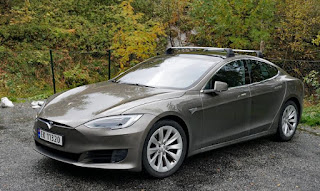When Will You Drive a Robocar?
By Diane Tait
 |
| Image courtesy flickr |
I just happened to be
channel surfing last night when I stumbled upon a recent episode of Nova that
was all about self-driving cars. After
taking the time to go through the evolution of fully and partially automated
cars, along with the aftermath of several fatal crashes, the show pointed out
the fact that like it or not, more and more cars on the road already have some
form of automation installed at the factory.
Think about it. What car doesn’t
come equipped with Cruise Control these days.
Some of the pricier models even have Adaptive Cruise where the car’s
speed is adjusted for the traffic ahead.
Most luxury models built today have what’s referred to as Lane Maintain
that’s designed to keep the vehicle between the dotted lines. Top of the line vehicles have automation that
do everything from hitting the brakes if a hazard appears ahead to automatic
lane change ability. My point is that
like it or not, automotive automation is creeping slowly but surely into every
vehicle built in this country. The
question is when, not if, our cars are going to push us all out of the driver’s
seat?
1. What’s
the Big Deal? – While many American motorists are convinced that they
can drive better than any robotic automobile, the statistics don’t bear this out. Especially
in today’s fast paced, distraction-filled driving environment, the average
motorist is literally an accident looking for a place to happen. What I mean by that is most motorists are
more focused on what’s happening inside their vehicle than an what’s happening
on the road. Think I’m stretching the
truth? Ask yourself this question, “When
you drive, do you keep your eyes on the road all the time, or do you look away
to change radio stations, take or make a phone call, send a text, or deal with
passengers and children? If you admit to
doing any of the above while behind the wheel, you’ve just confessed to putting
you and your passengers at peril every time you drive. What’s the big deal, you ask? When you consider that a car traveling 70 MPH
covers 102 feet every second, the big deal is should someone ahead slam on the
brakes while you’re distracted, the next sound you hear will be breaking glass. On the other hand, if your vehicle came
equipped with Adaptive Cruise Control, it would have applied the brakes and
stopped the car before a collision took place.
 |
| Image courtesy flickr |
3.
We’re Not at the Set It and Forget It Stage
Yet – Regardless of the
amount of automation built into vehicles today, there is currently no system available
that is designed to Set It and Forget It.
Try telling that to some car owners.
We’ve all seen drivers ignoring their primary driving function to pursue
some other issue while they drive.
Texting drivers are the worst, followed by people talking on the
phone. The only accident I was involved
in during the past 30-years occurred as I stopped at a red light only to hear
the squeal of brakes directly behind me as a Millennial looked up to see the traffic
had stopped. Fortunately, the collision
was so minor it failed to set off my car’s airbags. But it could have been very different had the
lad not looked up at all. The kid in the car behind me was lucky his smartphone
didn’t cost him his license. He might
not be as lucky the next time around.
 |
| Image courtesy flickr |
4.
Does Automotive Automation Really Make
Driving Safer? – While the headlines point out each and every
fatal crash caused by self-driving cars, the number of collisions caused by
semi or fully-automated vehicles pales in comparison to the number of crashes
caused every day by cars being driven by people. Since fully 90% of car crashes are due to
driver error, this speaks for itself.
Furthermore, industry statistics bears out the fact that semi and fully
autonomous vehicles are far safer. There
are several reasons for this. First of
all, automated vehicles never drive emotionally. They don’t experience road rage, they never
fall asleep at the wheel and they stay focused 100% of the time on the task at
hand. Secondly, they are better equipped
to see and react to the world around them.
Instead of having only one pair of eyes, they come equipped with
numerous sensors including cameras, radar and lidar that scans 360 degrees around
the vehicle. Thirdly they react 1,000
times faster to changes and hazards (provided they’re programmed to recognize
them).
5. What
About Driver Push-Back? – While there are still a number of drivers out
there who honestly believe that it’s their God given right to climb behind the
wheel, this kind of knee-jerk reaction will dissipate once drivers get
accustomed to their vehicles doing some of the decision making for them. The clincher will be when drivers of
self-driving cars start making lower insurance payments, as well as paying
fewer tickets for speeding. Within 10-years, all cars will be
highly automated, which will make the decision a moot point. If you’ve seen the reckless way that some
motorists drive, my attitude is the sooner the better when it comes to
automotive automation. Besides, whether
you realize it or not, if you own or lease a late model car, truck or van, you
already drive a robocar.
Diane Tait
owns and operates A&B Insurance. To find out more about how you can save
money on auto insurance, go to her site or fill out the form at right.


I'm ready for robocars. Too many Florida drivers are like kamikaze pilots.
ReplyDeleteYes, coming very soon (in less than 2 years). 5 G will make this a reality for those who like living on the bleeding edge and have the wherewithal to pay for it!
ReplyDelete